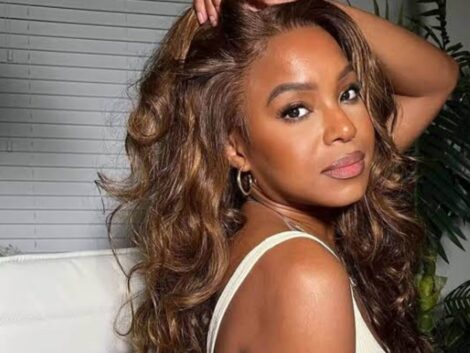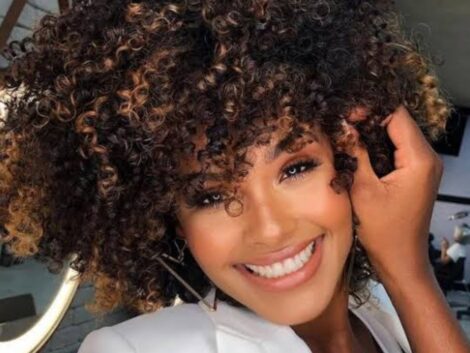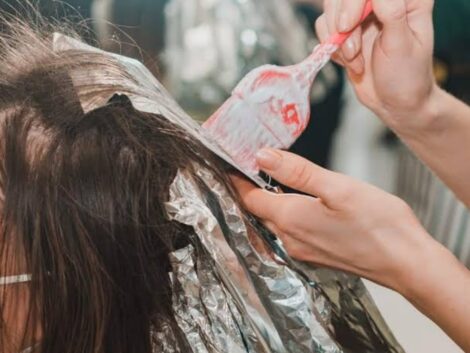A balayage can be done in a single session or multiple sessions, depending mostly on the desired look and starting hair color. Typically, it would take 1–3 sessions.
If the starting hair color is too dark, then more than 1 session might be helpful. Also, the length of the hair and the overall condition of the hair can be important factors when determining how many sessions are needed. Sometimes, the stylist’s expertise can also make a difference in the number of required sessions, as this whole style is done by hand.
How long does a balayage session take?
The duration of a balayage session can vary depending on several factors, such as the length and thickness of your hair, the desired outcome, and the skill and experience of the stylist. Typically, a full balayage session can take anywhere from 2 to 3 hours.
The required time includes consultation with the stylist to discuss your desired look, the actual coloring process, and the time needed for the color to develop. Keep in mind that if you have particularly long or thick hair or if you’re getting additional treatments done alongside the balayage (such as a haircut or toning), the session may take longer.

Why does a balayage take so long?
The process of achieving a balayage look can take longer compared to traditional highlighting methods for several reasons:
Hand-painting technique
Balayage involves the artistic application of color by hand. This method requires the stylist to have a high level of skill and expertise to place the highlights for a customized and natural effect strategically. The meticulous approach can be time-consuming.
Customization
Balayage is highly customizable to each individual’s hair color, texture, and desired outcome. The stylist must consider the client’s base hair color, skin tone, and haircut to create a personalized and flattering look. The level of customization can extend the processing time.
Gradual color transition
Balayage aims to achieve a gradual color transition from darker roots to lighter ends. Achieving this seamless effect requires the stylist to blend the colors and avoid harsh lines carefully. The gradual color progression may necessitate multiple layers of color, leading to longer processing times.
Lightening process
Depending on the starting hair color, achieving the desired lighter tones can take time. Darker hair may require more sessions to lift the color to the desired level.
Processing time
The development time for balayage highlights is longer than traditional foiling methods. The stylist may need to monitor the color development carefully to achieve the right shade.
Toning
After the initial color application, toning is often done to further refine and adjust the color. This step is crucial to eliminate any unwanted warmth or brassiness and to achieve the desired result.
While balayage may be time-consuming, most people find the natural and low-maintenance results well worth the extra time and effort.

What not to do before getting a balayage?
Before getting a balayage, there are certain things you should avoid doing to ensure the best possible results and maintain the health of your hair. Such as-
- It’s generally recommended not to wash your hair on the day of your balayage appointment. Natural oils on your scalp can act as a protective barrier during the color process and minimize potential scalp irritation.
- Refrain from using heavy styling products like gels, waxes, or oils before your appointment. These products can create a barrier on your hair, making it difficult for the color to penetrate evenly.
- Avoid using hot styling tools like straighteners, curling irons, or blow dryers on high heat in the days leading up to your appointment. Heat-damaged hair can affect how the color develops and holds in your hair.
- Exposure to the sun and chlorine from swimming pools can alter the condition of your hair and might affect the outcome of the balayage.
- Be sure to complete the consultation. Make sure to have a thorough consultation with your stylist before the appointment. Discuss your desired look, maintenance expectations, and any concerns. This will help your stylist understand your needs and tailor the balayage technique accordingly.
- Avoid attempting to do balayage at home, as it can lead to uneven results, unwanted color, and potential damage to your hair.
By following these guidelines and communicating openly with your stylist, you can help ensure that you get the balayage look you desire while keeping your hair healthy and beautiful.
What are the mistakes with balayage?
Balayage is a versatile hair coloring technique, but there can be mistakes that lead to less desirable results. Such as-
Overprocessing
Leaving the color on for too long or using high-volume developers can lead to overprocessed hair, causing damage, breakage, and an unnatural appearance.
Uneven application
Balayage requires precise hand-painting skills, and if not done carefully, it can result in uneven or patchy color distribution. This can be especially noticeable if the stylist hasn’t blended the colors properly.
Using the wrong products
Using low-quality products or bleach that is not suitable for the hair type can lead to subpar results and potential damage.
Ignoring hair condition
If the hair is already damaged or in poor condition, applying balayage can exacerbate the problem. It’s essential for the stylist to assess the hair’s health and suggest alternative treatments or conditioning options before proceeding with the balayage.
Not considering base color
Balayage works best when it complements the client’s natural base color. The result might look unnatural or unflattering if the chosen balayage tones clash with the base color.
Using too many lightening sessions
Attempting to achieve drastic lightening in a single session can cause significant damage to the hair. Balayage is often a gradual process, and multiple sessions may be required to achieve the desired result safely.
Failure to tone properly
After lightening the hair, toning is essential to neutralize any unwanted brassy or yellow undertones. Skipping this step or not using the correct toner can result in an undesirable color.
Neglecting maintenance
Balayage is known for its low maintenance, but some care is still required. Clients should follow the stylist’s advice on hair care and use appropriate color-safe products to prolong the balayage’s life and keep the color vibrant.
Miscommunication with the stylist
The client must communicate their expectations clearly with the stylist during the consultation. If the stylist misunderstands the desired outcome, it can lead to disappointment after the coloring process.
To avoid these mistakes, it’s essential to choose a skilled stylist.
What is the downside of balayage?
While balayage is a beautiful hair coloring technique, it’s important to consider the potential downsides before deciding to get it done. Such as:
Cost:
Balayage is a specialized coloring technique that requires skill and artistry. As a result, it can be more expensive than traditional highlights.
Time-consuming process
Balayage, especially for those with long or thick hair, can take a significant amount of time to complete. The hand-painting process and the need for precision make it a lengthier procedure compared to regular foil highlights.
Potential damage
While balayage is generally gentler on the hair than all-over bleaching, it still involves the use of bleach or lighteners to achieve lighter tones. Overprocessing or using strong bleaching agents can lead to hair damage and dryness.
Frequent touch-ups
While balayage is known for its low maintenance, the highlights will eventually grow out, and touch-ups may be required every few months to maintain the desired look.
Not suitable for drastic color changes
Balayage is more effective for achieving subtle, natural-looking highlights. If you want a significant shift in hair color, such as going from dark brown to platinum blonde, balayage may not be the most suitable technique.
Inconsistent results
The outcome of balayage can vary depending on the skill and experience of the stylist. If done correctly, the results may be balanced and meet the client’s expectations.
Not ideal for very short hair
Balayage is best suited for longer hair lengths to showcase the gradient effect. If you have very short hair, the balayage highlights may be less noticeable or effective.
Initial brassines
After the initial color application, some clients may experience slight brassiness or unwanted warm tones. Proper toning during the process and using purple shampoo afterward can help neutralize these tones.
Despite these downsides, most people love balayage for its beautiful, sun-kissed effect and low-maintenance appeal.
Lastly, check out the mane caper shop.



